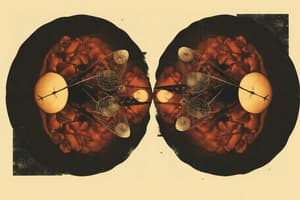Podcast
Questions and Answers
What is the function of kinetochores during mitosis?
What is the function of kinetochores during mitosis?
- Develop at the centromere region and attach to specific spindle microtubules (correct)
- Serve as the principal microtubule-organizing center
- Form spindle microtubules
- Anchor the centromeres to the cell membrane
During metaphase, where do the duplicated condensed chromosomes align?
During metaphase, where do the duplicated condensed chromosomes align?
- At the astral rays of the mitotic spindle
- At the kinetochore microtubules
- At the equatorial plate of the mitotic spindle (correct)
- At the centromere
What event characterizes telophase?
What event characterizes telophase?
- Replication of DNA in the nucleus
- Depolymerization of microtubules in the midbody (correct)
- Formation of the mitotic spindle
- Alignment of chromosomes at the metaphase plate
What are spindle microtubules that do not attach to kinetochores called?
What are spindle microtubules that do not attach to kinetochores called?
What happens during anaphase of mitosis?
What happens during anaphase of mitosis?
Where are nucleoli reestablished during telophase?
Where are nucleoli reestablished during telophase?
What is the function of the midbody in telophase?
What is the function of the midbody in telophase?
What initiates telophase cytokinesis in mitosis?
What initiates telophase cytokinesis in mitosis?
Which structure is responsible for polymerizing spindle fibers and astral rays in mitosis?
Which structure is responsible for polymerizing spindle fibers and astral rays in mitosis?
What happens if the mother centriole fails to move at the end of cytokinesis?
What happens if the mother centriole fails to move at the end of cytokinesis?
Which structure aids in the separation of daughter cells in telophase?
Which structure aids in the separation of daughter cells in telophase?
'Apoptosis' is a method used for what purpose?
'Apoptosis' is a method used for what purpose?
During anaphase I in meiosis, what happens to the chromatids?
During anaphase I in meiosis, what happens to the chromatids?
What is the function of spindle fibers during meiosis?
What is the function of spindle fibers during meiosis?
Which phase of meiotic division resembles anaphase in mitosis?
Which phase of meiotic division resembles anaphase in mitosis?
What occurs during telophase I of meiosis?
What occurs during telophase I of meiosis?
How does equatorial division (meiosis II) differ from meiosis I?
How does equatorial division (meiosis II) differ from meiosis I?
What is the role of kinetochores during cell division?
What is the role of kinetochores during cell division?
Flashcards are hidden until you start studying
Study Notes
Centrosome and Mitosis
- The centrosome contains centrioles and a pericentriolar cloud of material with γ-tubulin rings.
- It is the principal microtubule-organizing center (MTOC) of the cell.
- Centrosomes migrate to opposite poles of the cell, and from them, spindle fibers and astral rays of the mitotic spindle polymerize.
Chromosome Structure
- Chromosomes consist of two parallel sister chromatids attached at the centromere.
- Kinetochores develop at the centromere region and function as MTOCs.
Mitosis Phases
Prometaphase
- Nuclear envelope disappears, allowing chromosomes to disperse in the cytoplasm.
- Kinetochores complete development and attach to specific spindle microtubules, forming kinetochore microtubules.
Metaphase
- Duplicated condensed chromosomes align at the equatorial plate of the mitotic spindle and attach to spindle microtubules at their kinetochore.
Anaphase
- Chromatids separate at the centromere, and daughter chromosomes move to opposite poles of the cell.
- The spindle elongates.
- In the later stages of anaphase, a cleavage furrow begins to form around the cell as the contractile ring, a band of actin filaments, contracts.
Telophase
- Each set of chromosomes reaches the pole, and a deepening of the cleavage furrow occurs.
- The midbody (containing overlapping polar microtubules) is formed between the newly forming daughter cells.
- Microtubules in the midbody are depolymerized, facilitating cytokinesis and formation of two identical daughter cells.
- The nuclear envelope is reestablished around the condensed chromosomes, and nucleoli reappear.
Apoptosis (Programmed Cell Death)
- Apoptosis is the method of removing cells from tissues in an orderly fashion as a part of normal maintenance or during development.
- Cells that undergo programmed cell death have several morphological features.
Meiosis
- Meiosis is a type of cell division that occurs in gametes.
- It involves two successive divisions (meiosis I and meiosis II).
- Meiosis I involves genetic mixing, while meiosis II involves the separation of sister chromatids.
Meiosis I
- Anaphase I is similar to anaphase in mitosis, except that each chromosome consists of two chromatids that remain held together.
- Telophase I is similar to telophase in mitosis, with the nuclear envelope reestablished and two daughter cells formed via cytokinesis.
- Each daughter cell contains 23 chromosomes (n) but has a 2C DNA content.
Meiosis II
- Equatorial division (meiosis II) begins soon after the completion of meiosis I, following a brief interphase without DNA replication.
- The sister chromatids are portioned out among the two daughter cells formed in meiosis I.
- The stages of meiosis II are similar to those of mitosis, with the stages named similarly (prophase II, metaphase II, anaphase II, and telophase II).
- Meiosis II occurs more rapidly than mitosis.
Cytoplasm
- The cytoplasm contains three main structural components: organelles, inclusions, and the cytoskeleton.
Studying That Suits You
Use AI to generate personalized quizzes and flashcards to suit your learning preferences.




